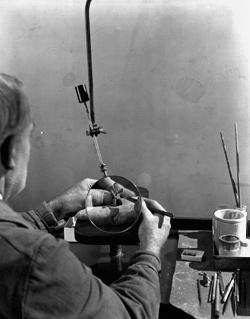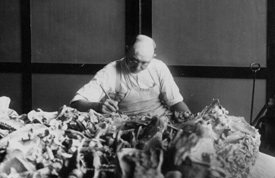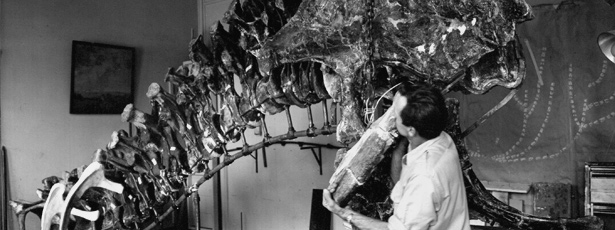Laboratories
Developing an efficient system for storing and preparing fossils was an essential first step in building a museum program in vertebrate paleontology. At the American Museum of Natural History, a flourishing program in mammalian paleontology, which had been established in 1891, was already overtaxed and so in 1898 the Museum set out to remodel the storage and work space for vertebrte paleontology.
The remodeled workspace for the Department of Vertebrate Paleontology was a major improvement for fossil preparation. Better lighting and ventilation in the new top-floor preparation lab made the work more pleasant, and elevated the visibility and prestige of fossil preparation.

By 1899 “state-of-the-art” systems in place included an overhead trolley system with chains and movable hoisting blocks attached to steel rails, which were used both to lift and move heavy blocks, and to suspend specimens while they were being fitted for mounting. The lab was wired for electricity, which provided power for reliable indoor illumination, and to power small electric motors, which in turn operated a multitude of essential tools.
A two-horsepower motor operated a large lathe, which drove a rotary diamond saw used for cutting stone and fossil bone; wheels for grinding and sharpening hand tools; a drill for boring specimens; and a small saw for cutting and splitting metal. A smaller motor ran the blower on a miniature gas blast furnace, which was used for heating and shaping metal armatures for mounting specimens and for tempering or reshaping metal tools.

By 1899 the Chicago’s Field Columbian Museum's lab space included a turning lathe, a workbench, and a sink with running water, but not enough space to work on the huge collection of Jurassic dinosaurs that had been collected in Colorado in 1900-01. New lab spaces added room for a closet, revolving worktables, and a skylight with sliding overhead curtains.
For information on equipment and setup of a modern fossil prep lab click here.
Resources
- Much of this page’s text was excerpted from Paul Brinkman’s 2009 paper “Dinosaurs, Museums, And The Modernization of American Fossil Preparation At The Turn Of The 20th Century”. To read more in depth about the second fossil wars and the development of fossil preparation at the American Museum of Natural History, The Chicago Field Museum and Pittsburgh’s Carnegie Museum download the complete text here.
- Download Adam Hermann’s articles to learn more about his techniques and materials:
- Visit the Academy of Natural Sciences’ online exhibit on Joseph Leidy and learn more about the challenges of early collecting and fossil preparation.
- Access archive images of expeditions, field notebooks and portraits from the American Museum of Natural History’s Division of Paleontology collections archive page.
- View additional historical images on exhibitions and expeditions from the American Museum of Natural History’s archives.
- Purchase a copy of Peter Whybrow’s 1985 article The History of Fossil Collecting and Preparation Techniques here.
Bibliography
Aaseng, Nathan. 1996. American Dinosaur Hunters. Springfield, NJ: Enslow.
Brinkman, P. 2009. “Modernizing American fossil preparation at the turn of the 20th century”. Methods in Fossil Preparation: Proceedings of the First Annual Fossil Preparation and Collections Symposium, Brown, M.A., Kane, J.F., and Parker W.G. Eds. pp.21-34.
Brinkman, Paul D., 2000. “Establishing vertebrate paleontology at Chicago’s Field Columbian Museum, 1893-1898”. Archives of Natural History 27:1 pp.81-114.
Colbert, Edwin H. 1984. The Great Dinosaur Hunters and Their Discoveries. New York: Dover.
Hermann, Adam, 1909. “Modern Laboratory Methods in Vertebrate Paleontology”, Bulletin of the American Museum of Natural History 26, pp. 283-331.
Hermann, Adam, 1908. “Modern Methods of Excavating, Preparing and Mounting Fossil Skeletons”, The American Naturalist 42:493 pp. 43-47.
Kissel, Richard A. 2007. “The Sauropod Chronicles” Natural History April pp. 34-38.
Osborn, Henry F. 1904. “On the Use of the Sandblast in Cleaning Fossils” Science n.s.19 no:476 p.256.
Riggs, Elmer S. 1903. “The Use of Pneumatic Tools in the Preparation of Fossils”, Science n.s. 17 no 436. pp. 747-749.
Rixon, A.E., 1976. Fossil Animal Remains: Their Preparation and Conservation. London: Athlone Press.
Spalding, David A.E. 1993. Dinosaur Hunters. Rocklin, CA: Prima.
Whybrow, Peter J. 1985. “A History of Fossil Collecting and Preparation Techniques” Curator 28:1 pp.5-26.


